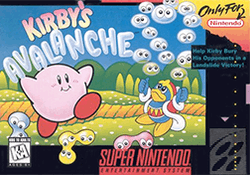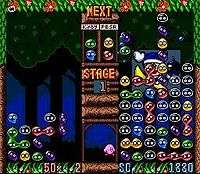Kirby's Avalanche
| Kirby's Avalanche | |
|---|---|
 Kirby's Avalanche cover art | |
| Developer(s) |
HAL Laboratory Compile Banpresto |
| Publisher(s) | Nintendo |
| Director(s) | Kazunori Ikeda |
| Producer(s) | Masamitsu Niitani |
| Programmer(s) | Takayuki Hirono |
| Artist(s) | Koji Teramoto |
| Composer(s) | Akiyoshi Nagao |
| Series | Kirby |
| Engine | Puyo Puyo |
| Platform(s) | Super NES, Virtual Console |
| Release date(s) |
Super NES Wii Virtual Console
|
| Genre(s) | Puzzle |
| Mode(s) | Single-player, Multiplayer |
Kirby's Avalanche, known in Europe as Kirby's Ghost Trap, is a puzzle video game co-developed by HAL Laboratory, Compile and Banpresto. It was released by Nintendo on February 1, 1995 in Europe and in April 25, 1995 in North America for the Super Nintendo Entertainment System. It is the western release of Super Puyo Puyo.
Gameplay

In the game, as in all Puyo Puyo games, groups of two colored blobs fall from the top of the screen. You must rotate and move the groups before they touch the bottom of the screen or the pile, so that matching-colored blobs touch from above, below, the left or the right. Once four or more same-colored blobs touch, they will disappear, and any blobs above them will fall down to fill in the space. If a player manages to set off a chain reaction with these blobs, rocks will fall on the other player's screen destroying it and causing them much woe. The number of rocks that falls depends on both the number of blobs popped and the number of consecutive chain reactions. These rocks will only disappear if a player manages to pop a group of blobs that are in direct contact with the rocks.
Plot
NOTE: The game's storyline in "Super Puyo Puyo" remains unchanged from the Arcade version. The story plot listed below is from the Western version of the game.
King Dedede has challenged Kirby and other members of Dream Land to a Ghost Trap/Avalanche Competition at the Fountain of Dreams. Kirby decides to take on the challenge, battling his way through the forest in Ghost Trap/Avalanche matches against an assortment of his old foes from Kirby's Dream Land and Kirby's Adventure (Including recurring bosses such as Whispy Woods, Kracko and Meta Knight), and ultimately to a final showdown at the Fountain of Dreams with King Dedede to win the Cup.
Version differences
While the core gameplay remains the same, the Japanese and Western versions are drastically different cosmetically. As the story in Super Puyo Puyo is more focused on Arle and Carbuncle's adventures like the Madou Monogatari and Mega Drive Puyo Puyo versions, the Western version replaced them with Kirby characters to appeal to Western audiences.
As a game released later in the SNES's life cycle, this game has bright colors and advanced graphics for its time. The sound consists of remixed tracks from Kirby's Adventure and Kirby's Dream Course, with only one original track from the Puyo Puyo game itself (the panic music). As the game boots, a sampled "Kirby's Avalanche!" can be heard.
Both versions have cinematics between each round, with differences being Kirby and his opponents shown having full conversations and trash-talking each other in full sentences in the Western version, and that Kirby's personality comes off as a lot more sarcastic and confrontational. This differs greatly from other Kirby games, where Kirby hardly speaks at all and is also much friendlier in general, as Arle and Carbuncle were in the Japanese version.
Port
In Europe and Australia, the game was rereleased on the Wii's Virtual Console service on July 27, 2007, and in North America on September 24, 2007. It costs 800 Wii Points.
The game is identical to the original release, except for one minor change: a cheat code that was given after completing Competition Mode which originally had to be entered on controller 2 can now be entered on both controller 1 and controller 2.
Reception
| Reception | ||||||||||||||||||||
|---|---|---|---|---|---|---|---|---|---|---|---|---|---|---|---|---|---|---|---|---|
| ||||||||||||||||||||
Kirby's Avalanche received generally positive reviews, garnering an aggregate score of 74% on GameRankings based on seven reviews.[3] IGN awarded the game 7.5 out of 10, comparing it favorably to Dr. Robotnik's Mean Bean Machine, another Super Puyo Puyo clone released for the Sega Genesis in North America.[6] GamePro commented that "Although Kirby's Avalanche is a rehash of an overdone puzzler theme, it's so well done that it's worth playing - that is, if you don't already have three puzzle games just like it." They particularly praised the graphics and the cuteness of the digitized speech.[4]
References
- ↑ "Kirby's Avalanche - Super NES - GameSpy". GameSpy. August 2009. Retrieved 2009-08-11.
- ↑ "IGN: Kirby's Avalanche". IGN. August 2009. Retrieved 2009-08-11.
- 1 2 "Kirby's Avalanche for Super Nintendo". GameRankings. Retrieved 2016-08-05.
- 1 2 "ProReview: Kirby's Avalanche". GamePro. IDG (70): 84. May 1995.
- ↑ Provo, Frank (October 2, 2007). "Kirby's Avalanche Review". GameSpot. CBS Interactive. Retrieved August 10, 2016.
- 1 2 Thomas, Lucas M. (September 26, 2007). "Kirby's Avalanche Review". IGN. Ziff Davis. Retrieved June 2, 2016.
- ↑ Duyn, Marcel (July 7, 2007). "Review: Kirby's Avalanche (SNES)". Nintendo Life. Retrieved August 10, 2016.
- ↑ "Now Playing". Nintendo Power. No. 69. February 1995. p. 107.
External links
- Official Nintendo Minisite (US)
- Official Nintendo Minisite (UK)
- Official Nintendo Minisite (Australia)
- Kirby's Avalanche at MobyGames